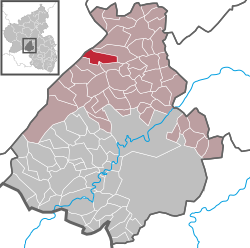Hellertshausen
| Hellertshausen | ||
|---|---|---|
|
||
| Coordinates: 49°49′17″N 7°16′38″E / 49.82139°N 7.27722°ECoordinates: 49°49′17″N 7°16′38″E / 49.82139°N 7.27722°E | ||
| Country | Germany | |
| State | Rhineland-Palatinate | |
| District | Birkenfeld | |
| Municipal assoc. | Rhaunen | |
| Government | ||
| • Mayor | Karl-August Piontek | |
| Area | ||
| • Total | 7.47 km2 (2.88 sq mi) | |
| Elevation | 470 m (1,540 ft) | |
| Population (2015-12-31) | ||
| • Total | 182 | |
| • Density | 24/km2 (63/sq mi) | |
| Time zone | CET/CEST (UTC+1/+2) | |
| Postal codes | 55758 | |
| Dialling codes | 06786 | |
| Vehicle registration | BIR | |
| Website | www.hellertshausen.de | |
Hellertshausen is an Ortsgemeinde – a municipality belonging to a Verbandsgemeinde, a kind of collective municipality – in the Birkenfeld district in Rhineland-Palatinate, Germany. It belongs to the Verbandsgemeinde of Rhaunen, whose seat is in the like-named municipality.
Hellertshausen lies in the Hunsrück on the southern edge of the Idar Forest. The municipal area is 71.2% wooded.
Hellertshausen borders in the north on the municipality of Stipshausen, in the east on the municipality of Hottenbach, in the south on the municipality of Asbach and in the west on the municipality of Schauren.
In 1331, Hellertshausen had a documentary mention as Hildertusin.
The council is made up of 6 council members, who were elected by majority vote at the municipal election held on 7 June 2009, and the honorary mayor as chairman.
Hellertshausen’s mayor is Karl-August Piontek.
The German blazon reads: In geteiltem Schild oben in Grün ein silberner Spaten, begleitet von zwei goldenen Ähren. Unten in Gold ein wachsender blaubewehrter und -gezungter roter Löwe.
The municipality’s arms might in English heraldic language be described thus: Per fess vert a spade sans helve argent above two ears of wheat with stalks in saltire Or, and Or issuant from base a demilion gules armed and langued azure.
The ears of wheat refer to the municipality’s agricultural structure, while the spade recalls the hammermill called “Hammerbirkenfeld”, at which such articles were made. The lion charge below the line of partition is a reference to the village’s former allegiance to the Waldgraves and Rhinegraves, who had the greatest share of holdings in the village alongside the Electorate of Trier and the “Further” County of Sponheim.
...
Wikipedia



